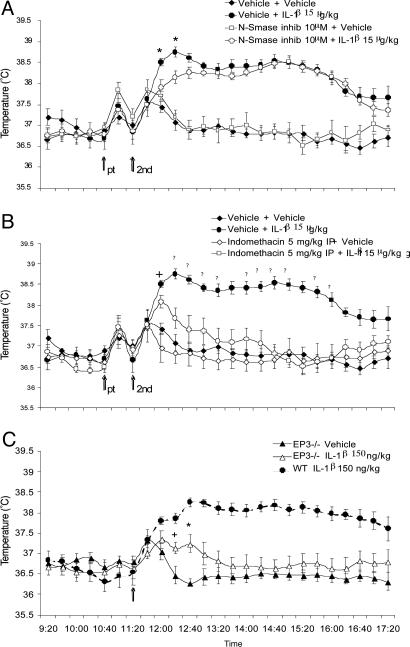Fig. 2.
Inhibition of the different phases of fever response by intrahypothalamic application of N-Smase inhibitor, spiroepoxide, or i.p.-administered indomethacin. Pretreatment (pt) was followed by second treatment (2nd) (see arrows). (A) N-Smase inhibitor 10 μM pretreatment inhibited partially the effect of IL-1β at 40 and 60 min; F(3, 16) = 13.887; ∗, P < 0.01, vehicle + IL-1β vs. vehicle + vehicle, N-Smase inhibitor 10 μM + IL-1β 15 μg/kg, and N-Smase inhibitor 10 μM + vehicle. After 60 min, the vehicle + IL-1β and N-Smase inhibitor 10 μM + IL-1β 15 μg/kg differ with vehicle + vehicle and N-Smase inhibitor 10 μM + vehicle groups; F(3, 16) = 38.741, P < 0.01. (B) Pretreatment with indomethacin does not have an effect on the early phase of the IL-1β increase on CBT at 40 min (see +, F(3, 16) = 18.541, P < 0.05, vehicle + IL-1β vs. indomethacin + vehicle, vehicle + vehicle) but interferes with the development of the fever response after 60 min (F(3, 16) = 21.342; ▾, P < 0.01). (C) The rapid rise in CBT in response to IL-1β is unaffected by the null mutation of the prostanoid receptor type 3; EP3R (paired t test, +, P < 0.05 at 60 min and ∗, P < 0.01 at 80 min, vehicle vs. IL-1β 150 ng/kg).

